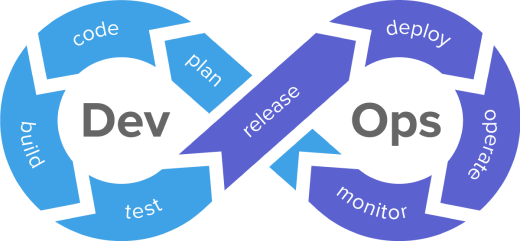DevOps Services
DevOps Services for Faster Time to Market
We integrate high-end DevOps solutions that bring in required team transparency
to create a seamless, highly efficient and unique application
that reaches the market on time.
DevOps Consulting Services and Solutions Company
Agile DevOps the culture and mantra for companies to achieve development, operations, testing and security in an efficient way and go to market in a faster way.We deliver agile DevOps services that help companies to automate their entire development and operations process intelligently which eventually paves the way to build quality and safe code by providing agile development, Continuous Integration, Continuous Security, Continuous testing and continuous delivery.Our DevOps services provide solutions in the broad spectrum such as supporting leading cloud platforms like AWS, Azure and GCP.Our DevOps services also include deployment modules like Microservices and Serverless architecture that covers IoT, Industry 4.0, Health Care, and other engineering verticals.
Best DevOps Service providers
(DevOps as a Service)
We provide end-to-end DevOps services, so, you no need to worry about Operations, you can concentrate on the development activity, we will take care of the entire DevOps and works as part of your arm. We have a promising team of DevOps experts who are highly proficient in providing cloud services like AWS, Amazon and GCP.
We provide DevOps consulting, DevOps architecture, active management, continuous optimization and improvement services. We build a proven DevOps culture, which will bring a seamless integration between the different team, which will make the software delivery on time with quality and security stably.
We follow agile and lean principles for DevOps, which will provide interoperability between different teams and helps to deliver on-time software product.

DevOps &
Azure services

DevOps &
AWS services

DevOps & GCP
( Google cloud platform) services
DevOps Strategy
DevOps is a Strategy?
Yes, an ecosystem which enables the successful delivery of software on time with a stable release. A good DevOps strategy decides the success in the cloud. The entire process and deployment activities are automated.
Requirements Planning
In the initial phase, we carry out a complete analysis of your application scenario and frame an exclusive DevOps strategy.
Defining DevOps Process
DevOps process completely goes exclusive hand-in-hand for organizations, and the core aim of the DevOps process is to make software delivery on time with high stability. In older way of software delivery, there will be ractive based opertaions, but after implementing DevOps, there will be proactive operations.
Understanding the deifference between old way of software delivery and new way of Devops based software delivery.
| Old way | New way |
|---|---|
| Software is build and shipped | Services are run and managed |
| Development features is done | Services are never done until turnerd off |
| Product owners focus only on features | Product owners own operational results |
| Each silo owns its own ownership | Entire team focused on end user satisfaction |
| Dev must depends on operations team to get work done | Ops enable Developer to get work done |
| Ops monitors apps | DevOps monitors Developer tools and operations app |
| Centralized | Decentralized and continuous |
| Highrisk event | Non Event |
| Disseminated | Actionable |
| Need big team size | Need micro team size |
DevOps
DevOps is a vibrant and trending practice implemented by various software creators to develop highly efficient, on-time, and flawless software products. Earlier software firms used to follow the stereotypical approach of carrying out the development and operational process separately, which ate a huge amount of completion time added up with complexities, the introduction of DevOps culture brought in the required transparency in software development and helped in creating on-time software products through coordinated work.

Why Organizations need DevOps?
- On-time market delivery
- Quick turn around time for Software
- Reduced Spending towards individual resources
- Development and Operations work together
- Workflow Transparency maintained
- Minimized Development Error
- Eliminates Security Risks
- Well-supported Automative Process
Continuous Development
Continuous development refers to a collection of chain processes like continuous integration, continuous delivery, continuous testing and continuous deployment that operates in an automated way and helps to deliver a flawless and timely software product with their combined efforts.
By using Continuous development approach, now the bugs in software can be fixed on the spot and a completely error-free software product can be delivered to the client by optimizing testing, bug-fixing time and resource.
Benefits of Continuous Development
Quick Software Updates
The incorporation of Continuous Development helps in updating a new feature on a software product easily, and it also projects the hidden bugs effortlessly through its automated working process that eventually leads to a higher return on investment.
Quality Enahncement
Since continuous development operates on an automated process, it used to receive on spot user feedback and rectify its errors, which would result in the development of better software product.
Zero- Risk
The whole concept of continuous development involves creating a better quality software product by following simple, miniature steps that avoid building a completely false product which would end up in failure.
Decreased Requirement for Resources
The traditional method of software creation or updation purely involves a mammoth task that demands a huge base of developer resource and time. The continuous development is a contradictory process follows automation and hence requires comparatively less number of resource and time for development or updation.
Improved Fecundicity
Receiving continuous feedback on software updation or creation the productivity rate of a developer gets exponentially increased, and they tend to involve in various activities of creating an even better software within the stipulated time.
Continuous Integration (CI)
Being the subset of Continuous Development, Continuous Integration (CI) encourages code creators to frame development modules according to the end customer requirement by avoiding the creational intention of project completion.
The entire process of software development gets categorized into several sub-modules where it creates a new approach of code creation, running and testing particular sub-set of the entire programming before storing it to the code repository for software development.
Continuous Delivery (CD)
Continuous Delivery is another important sub-module of Continuous Development, and sequel of Continuous Integration got involved in the process of creating high quality and error-free software.
The Continuous Delivery process ensures that the collection of codes gets tested on time and carried on to the next level of production deployment to embed it into the process of converting the code into a software product.

Benefits of Continuous Integration
In the case of software development, the delayed feedback on the quality of code is the actual X factor that hurts its progress, by deploying the Continuous Integration tools properly the entire software development process can be carried out in a frictionless way by denoting the pullback factors on time.
The deployment of Continuous Integration enables transparency between the development and testing departments hence creating a positive space to plan and act coordinately.
The entire software product is a combined set of codes (aka program) that plays the role of the operator in functioning the specific application flawlessly every individual code is perfect as an individual but combining them is one hectic task. Continuous Integration highly simplifies the way integration is carried out in software development and assures deliverance of a well-structured product.
Finding numerous bugs and fixing them again into the development process is the most tedious task which might slow down the pace of software development, the continuous integration process will gear up the entire development activity by spotting and fixing the errors immediately.
Finding numerous bugs and fixing them again into the development process is the most tedious task which might slow down the pace of software development, the continuous integration process will gear up the entire development activity by spotting and fixing the errors immediately.
An easily testable set of codes are meant to be with good quality, and it would certainly provide space to write code for testing, this particular characteristic portrays the flexibility of Continuous Integration and eventually simplifies the testing process.
Benefits of Continuous Delivery
The whole concept of Continuous Development brought into the software development process to accelerate its working speed but, delivering quality codes for development is mandatory too. Hence Continuous Delivery emits the character of responsible acceleration in software creation that helps to create flawless and on-time software products.
The increase in productivity amongst developers is visible post-deployment of the Continuous Delivery process where it helps by getting notified with the on-going bugs and rectify their mistakes which sharpens the learning curve and encourages to try different development approach and also minimizes the overall development time.
Adoption of technology has become mandatory these days irrespective of the industry, implementing a continuous pipeline automated process would ease up the repeated task burden on employees and allows them to focus on crucial aspects. The automation of basic repeated tasks would trigger up your performance and gives a long-lasting competitive edge.
It is always better to monitor whether you are building the right product instead of verifying the built product was right. The Continuous Delivery approach follows the prevention mechanism and validates the software in its initial phase to avoid future chaos.
By reducing the release based errors, Continuous Delivery has brought in the required reliability amongst the client base and eventually earned trust in its deployment methodology.
Continuous Testing
Continuous Testing falls under the umbrella of Continuous Development that contribute towards DevOps processing. To deliver a high-quality software product Continuous testing maintains consistency, flexibility and completeness in its process.
The entire process of continuous testing is automated, which paves the way to early and easy testing and high-quality code production.
Benefits of Continuous Testing
Reduced Application risks
Continuous testing ensures quick turn around time in software development and also make it error-free. Quick turn around time involves a change in code, which would cause an error in developing software. By using a continuous testing method the vulnerability towards error occurrence in code dynamism can be implemented.
On-time Release
Since, testing is carried out in every phase, the product release at its scheduled time without disappointing the target crowd and the client.
Code testing transparency
The module-wise testing brings in a great level of transparency in the software development process between the development peers and also help them let know about the immediate change that happens with code transformation.
No Need for Code Review
The continuous testing methodology involves phase-wise testing, and hence, it eventually cut down the time taken for complete testing review which runs of hours.
Maximum Test Coverage
Since the continuous testing approach is automated, it ultimately helps the development team with their test coverage and doesn’t even miss out a single error that occurs during code transformation.


